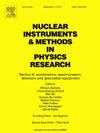6LiI:Eu/LaBr3:Ce phoswich detector for detection and discrimination of thermal neutron and gamma radiation
IF 1.5
3区 物理与天体物理
Q3 INSTRUMENTS & INSTRUMENTATION
Nuclear Instruments & Methods in Physics Research Section A-accelerators Spectrometers Detectors and Associated Equipment
Pub Date : 2025-03-19
DOI:10.1016/j.nima.2025.170428
引用次数: 0
Abstract
A phoswich detector consisting of 6LiI:Eu (2 mm L x 25 mm dia) and LaBr3:Ce (20 mm L x 25 mm dia) single crystal is developed to detect and discriminate thermal neutrons and gamma radiation employing pulse shape discrimination (PSD) and pulse height discrimination. The thicknesses of the 6LiI:Eu crystals is kept to ∼2 mm to make it transparent to high energy gamma along with maximum efficiency for thermal neutron detection. We are able to discriminate neutron interaction in 6LiI:Eu from the gamma event detected in both LaBr3:Ce and 6LiI:Eu by pulse height as well as PSD cutoffs. The figure of merit for discriminating thermal neutron (in 6LiI:Eu) from high energy gamma radiation (in LaBr3:Ce) is approximately 11. Further, by adding a Bi4Ge3O12 (BGO) crystal as top layer in this phoswich detector we can detect and discriminate charged particles like alpha and beta along with thermal neutron and gamma.
6LiI:Eu/LaBr3:Ce光子探测器,用于热中子和伽马辐射的探测和识别
研制了一种由6LiI:Eu (2mm L × 25mm直径)和LaBr3:Ce (20mm L × 25mm直径)单晶组成的光子探测器,利用脉冲形状鉴别(PSD)和脉冲高度鉴别技术探测和鉴别热中子和伽马辐射。6LiI:Eu晶体的厚度保持在~ 2mm,以使其对高能伽马透明,并具有最大的热中子探测效率。我们能够通过脉冲高度和PSD截止来区分6LiI:Eu中的中子相互作用与LaBr3:Ce和6LiI:Eu中检测到的伽马事件。区分热中子(在6LiI:Eu中)和高能伽马辐射(在LaBr3:Ce中)的优值约为11。此外,通过在光电探测器的顶层添加Bi4Ge3O12 (BGO)晶体,我们可以探测和区分像α和β这样的带电粒子以及热中子和γ。
本文章由计算机程序翻译,如有差异,请以英文原文为准。
求助全文
约1分钟内获得全文
求助全文
来源期刊
CiteScore
3.20
自引率
21.40%
发文量
787
审稿时长
1 months
期刊介绍:
Section A of Nuclear Instruments and Methods in Physics Research publishes papers on design, manufacturing and performance of scientific instruments with an emphasis on large scale facilities. This includes the development of particle accelerators, ion sources, beam transport systems and target arrangements as well as the use of secondary phenomena such as synchrotron radiation and free electron lasers. It also includes all types of instrumentation for the detection and spectrometry of radiations from high energy processes and nuclear decays, as well as instrumentation for experiments at nuclear reactors. Specialized electronics for nuclear and other types of spectrometry as well as computerization of measurements and control systems in this area also find their place in the A section.
Theoretical as well as experimental papers are accepted.

 求助内容:
求助内容: 应助结果提醒方式:
应助结果提醒方式:


